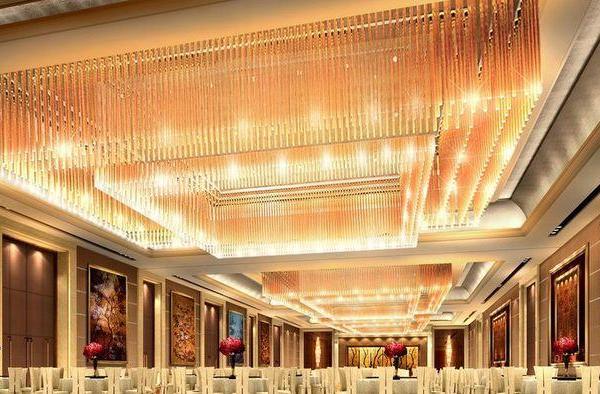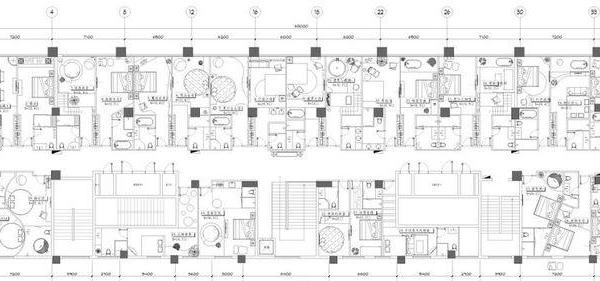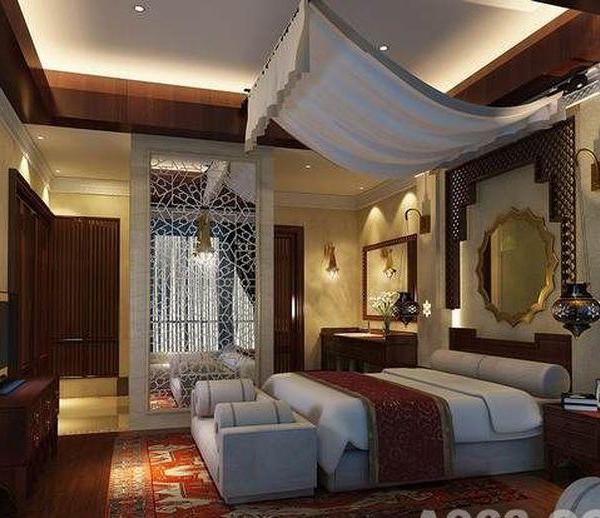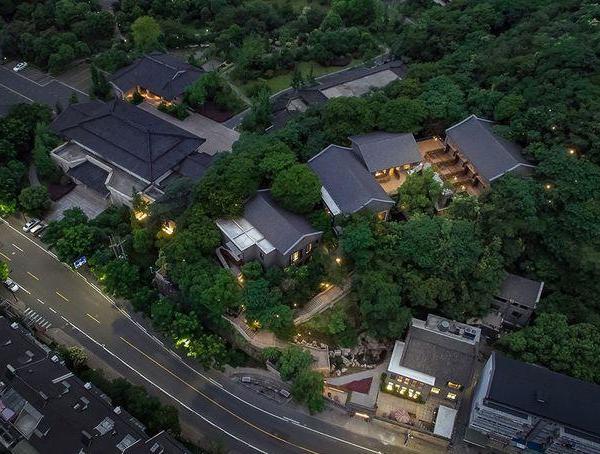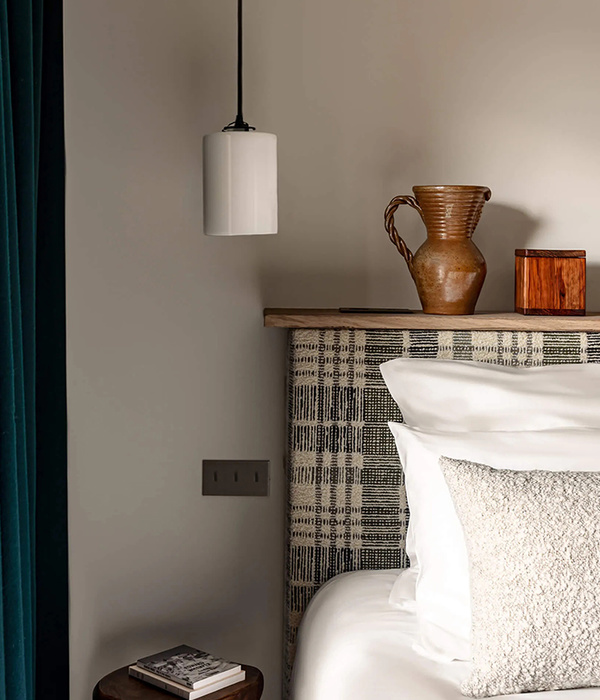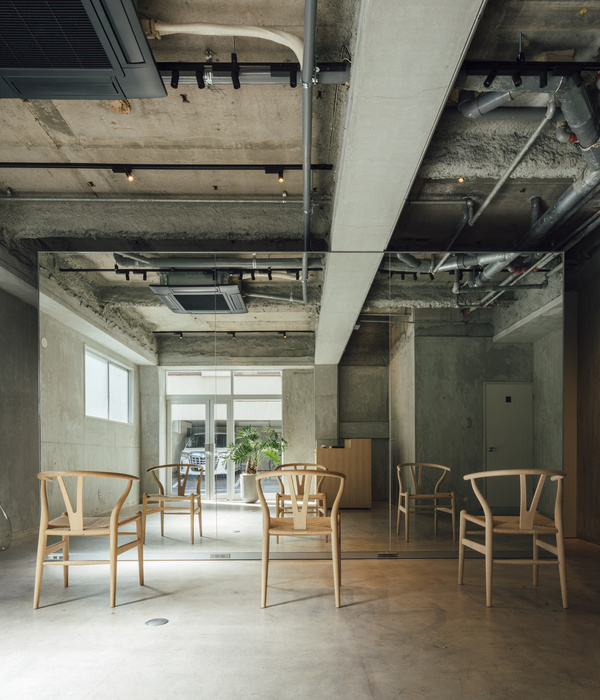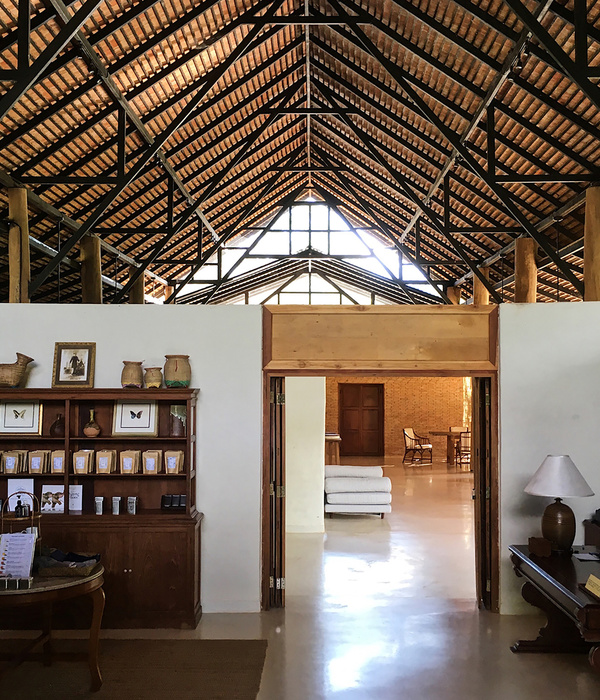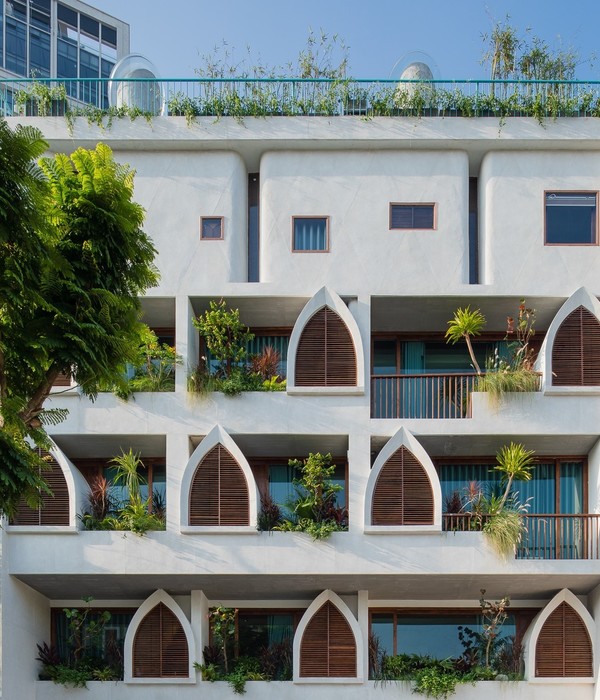在意大利 Alto Garda 的阿尔科小镇,noa*事务所将一座修建于 17 世纪的修道院改造成了一座独具特色的酒店,同时保持了建筑本身固有的魅力与平和的氛围。位于花园中的水疗空间从经典的乡村建筑中汲取出灵感——从附近的湖岸便可以发现。
The monumental spaces of a 17th century monastery are brought back to life in Arco, Alto Garda, where noa* has transformed them into a unique hotel, while conserving the charm of the original architecture and its atmosphere of peace and meditation. In the garden, the spa is inspired by certain typical rural constructions, which can be found on the lakes shore.
▼项目概览,general view© Alex Filz
该项目主要分为两个阶段: .将修道院及其内部空间改造为酒店:在首层创建公共空间(接待区、大堂、早餐区、酒吧区和厨房),二层和顶层主要用于容纳客房。 .在植被茂盛的花园中引入一个新的疗养区,包括 500 平方米的放松区、治疗室、桑拿房以及带有蒸汽浴室的疗养体验区。
The noa* project consisted of two main phases:- The renovation and conversion of the monastery and its interiors into a hotel, achieved by creating common spaces (reception, lobby, breakfast room, bar area and kitchen) on the ground floor with the rooms mainly distributed between the first floor and the loft.- The development of a new Wellness area within the lush garden: 500 square metres of relaxation rooms, treatment rooms, saunas and a wellness course with steam bath.
以上这些干预措施最终形成了一个独具特色的酒店,正如建筑师 Francesco Padovan 所言:“这是一个将你带回过去的世外桃源,它紧密地围绕着其所在地方的历史与特征。每一处建造和材料上的细节都经过了仔细斟酌,以保证在延续场地庄严氛围的同时,使其升华并赋予其新的生命。”
These interventions have resulted in a very particular hotel, as architect Francesco Padovan highlights: “A refuge that takes you back in time, closely centred around the history and the particular features of this place. And where every construction choice, every material and detail, has been studied to draw on the majesty of the pre-existing context, exalting it and giving it new life”.
▼酒店主体建筑与周边环境,the hotel building and the context© Andrea Dal Negro
改造后的酒店被命名为 Monastero Arx Vivendi,共包含 40 间客房(其中有 2 间套房),旨在为客人带来极致和谐的体验。从设计上看,该方案最基本的思路是在保持经典的修道院建筑及其内部路径的前提下,将其在几何学上的严谨性延续至新建的体量当中,同时密切关注材料与色彩的选择。
With its 40 rooms (including 2 suites), the Monastero Arx Vivendi – the name of the new hotel – offers hospitality in full harmony with the spectacular location. From a design perspective the underlying idea was to maintain the typical monastery architecture, preserving the original design of the internal paths and extending its geometrical rigour to the new volumes, paying close attention to the choice of materials and colours.
花园,garden© Alex Filz
▼从水疗区望向酒店建筑,view from the wellness area© Alex Filz
▼朝向庭院的视野,view towards the courtyard© Alex Filz
原先的修道院被 7 米高的围墙所环绕,设计团队将其原始外观保留下来,并将其内部的空间分为三个楼层。
首层公共空间的设计强调了修道院既有的平面布局——接待区、早餐区和阅览/休息室沿着中轴线分布,并被优美的扇形肋穹顶统一覆盖,外围则是连续的走廊空间。
酒吧和厨房也位于首层,此外还置入了一间带有私人花园的酒店套房。
Completely enclosed by a 7-metre high boundary wall whose original appearance has been preserved, internally the monastery is distributed across three levels.
As such, the development of the common spaces on the ground floor emphasised the existing plan of the monastery – located along the central axis is the reception, the breakfast room and a reading room/lounge, all embellished with beautiful rib vault ceilings and surrounded by a long continuous corridor. The bar and kitchen are also situated on the ground floor. A suite with a private garden was also created on this level.
▼首层空间,ground floor© Alex Filz
▼中央走廊被优美的扇形肋穹顶覆盖© Alex Filz the central axis embellished with beautiful rib vault ceilings
▼走廊细节,detailed view© Alex Filz
楼梯,staircase© Alex Filz
接待区,reception© Alex Filz
接待区上空悬挂着极简吊灯© Alex Filz the reception is illuminated by a‘shower’of minimalist hanging lamps
▼休息室,lounge© Alex Filz
▼餐厅,dining area© Alex Filz
吧台和自助餐室,bar area and buffet room© Alex Filz
▼户外水车装置,thewaterwheel© Alex Filz
在二层,宏伟的中央走廊顶部排列着跨度近 50 米的木制横梁,带来与首层截然不同的体验。走廊两侧是原有的修道院小房间,它们如今两两相连,形成更加宽敞(22 平方米--30 平方米)的酒店房间。
The scenery changes on the first floor where the majestic central corridor is lined by ceiling beams which stretch out to an impressive length of almost 50 metres. Here, the former monastic cells, aligned along the sides, were joined two-by-two to create larger rooms (from 22 to 30 square metres).
▼二层走廊,the central corridor on the first floor© Alex Filz
三层空间同样十分引人注目。宽敞的阁楼顶部以醒目的桁架支撑,两排客房被设置在中央走廊的两侧。经过修复的木制桁架回应了其原始的功能。在屋顶的最高点,条带状的天窗延伸至整个天花板的长度,在照亮走廊的同时还借助气窗使光线进入客房。
The second floor is no less striking. A large loft area topped by eye-catching trusses, which host two lines of rooms that open out onto a long central corridor. The restored wooden trusses pay homage to their original function. At the highest point of the roof, a skylight runs right along the length of the ceiling, not only illuminating the corridor but also the rooms thanks to the transom windows.
三层走廊,the central corridor on the second floor © Alex Filz
▼仰视天窗,skylight© Alex Filz
在修道院花园内,新修建的水疗中心由 7 个轻盈的玻璃和金属体量组成,并沿着一道石砌的墙体分布。玻璃体量和绿植庭院交错出现,创造出引人入胜的空间张力。
起到连接作用的墙体由一系列立柱定义,其外部以维琴察石材包覆,颜色使人联想到场地中既有的建筑,以及用喷砂混凝土预制的横向门楣。该设计同时也呼应了沿修道院东侧延伸的通道所使用的石砌壁柱。
Newly-developed in the monastery garden, the spa consists of seven light glass and metal volumes positioned along a stone spine. The alternation of glass bodies and green courtyards creates an evocative pattern of advanced and set-back volumes.
The connecting spine – composed of a series of pillars covered in Vicenza stone, whose colours recall the pre-existing structures, and a horizontal architrave in pre-fabricated and sandblasted concrete – echoes the stone pilastrade of the raised channel that runs along the eastern side of the convent.
▼7 个轻盈的玻璃和金属体量沿着一道石砌的墙体分布,seven light glass and metal volumes are positioned along a stone spine© Alex Filz
▼从酒店建筑俯瞰水疗中心,view towards thespa from the hotel building© Alex Filz
绿植庭院,the green courtyard© Alex Filz
▼景观细节,landscape details© Alex Filz
疗养区包括三个放松区和一个治疗区。其中第一个放松区设有休闲躺椅;第二个放松区面向“biolake”——一个深蓝色的天然水池;第三个放松区位于绿植庭院内的开放走廊。另外还配备了桑拿(生物桑拿和芬兰桑拿)和类似于土耳其浴室的疗养体验区,后者的中央是一块巨大的、被烧热的石头。
The wellness area includes a first relaxation area with loungers, a treatment area and a second relaxation area facing the ‘biolake’, a pool of natural water with dark blue tints. Next is a third relaxation area in an open gallery in the green courtyards, then the saunas (a bio sauna and a Finnish sauna) and a particular type of hammam or wellness course that revolves around a large heated dark stone.
▼水池,the pool© Alex Filz
▼从休息区望向水池,view from the relaxation area© Alex Filz
玻璃和金属体量,the glass and metal volume© Alex Filz
▼长椅休息区,the relaxation area with loungers© Alex Filz
▼桑拿室和疗养体验区,sauna and wellness course © Alex Filz
一层空间既有的天花板和装饰得到了保护和修复。空间色调以黑白灰为主,回应了修道院的历史色彩。
二层中央走廊的地板是在既有地面的基础上修复而成,并且有意地未摆放任何家具。房间的设计和选材均十分严谨:卧室地面采用手刨橡木;浴室瓷砖采用天然纹理;家具采用黑色,与房间的灰色调形成对比。所有物件都是为酒店专门定制,包括带有黑色镶木嵌入元素的金属四柱床。
顶层的房间采用了相同的风格,但做出了一些现代层面的让步,例如采用了更加柔和的颜色、带有靠枕的床和陶瓷灯饰等。
The original ceilings and decorations in the common spaces on the ground floor were conserved and restored. The dominant shades are white, grey and black, the historic colours of the monastery.
On the first floor the majestic central corridor, whose cotto floor has been rebuilt on the basis of the existing floor, has been deliberately left free of furnishings. All of the rooms share a very rigorous design, also in terms of the material choices: floors in hand-planed oak for the bedroom and natural-look tiles for the bathroom. Black has been chosen for the furniture, including that of the bathroom, standing out against the grey of the rooms. Everything is custom-designed, including the metal four-poster beds with black oak inserts.
The rooms in the loft adopt the same style, but with a few extra concessions to modernity – softer colours, padded beds for acoustic comfort and ceramic lamps.
▼凉廊套房,Suite Loggia© Alex Filz
▼凉廊空间,loggia space© Alex Filz
▼凉廊套房浴室,bathroom© Alex Filz
花园套房,Suite Hortus© Alex Filz
▼花园空间,the garden area© Alex Filz
标准客房,Guestroom Cella© Alex Filz
▼阁楼客房,Guestroom Lux© Alex Filz
室内细节,interior detailed view© Alex Filz
场地位置,location map© noa*
酒店建筑一层平面图,ground floor plan –monastero© noa*
酒店建筑二层平面图,first floor plan –monastero© noa*
▼酒店建筑三层平面图,second floor plan –monastero© noa*
▼水疗中心一层平面图,ground floor plan – wellness© noa*
▼水疗中心剖面图 AA,section – wellnessAA© noa*
▼水疗中心剖面图 BB,section – wellnessBB© noa*
▼水疗中心剖面图 CC,section – wellnessCC© noa*
▼酒店建筑剖面图 AA,section – monastero AA© noa*
▼酒店建筑剖面图 BB,section – monastero BB© noa*
▼酒店建筑剖面图 CC,section – monastero CC© noa*
Project name: Monastero
Typology: Hotel, wellness
Location: Arco, Trentino (Italy)Client: Stephanie Happacher & Manuel Mutschlechner
Architecture: noa* network of architecture
Interior Design: noa* network of architecture
Construction start: August 2020
Completion: May 2021
Intervention: Hotel conversion and new construction wellness
Volume: 1.560 m3 (wellness). 15.600 m3 (monastero)Surface area: 520 m2 (wellness). 3.780 m2 (monastero)Text (IT): Laura Ragazzola
Translation (EN): Landoor
Photographs: Alex Filz
Photographs(EN) Drone: Andrea Dal Negro
{{item.text_origin}}


